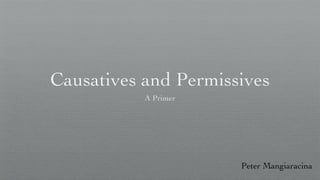
Causatives and Permissives
- 1. Causatives and Permissives A Primer Peter Mangiaracina Monday, December 20, 2010
- 2. Disclaimer The slideshows in this series are not meant to be comprehensive, but rather starting points for further study by Intermediate students of ESL (English as a Second Language). Peter Mangiaracina Monday, December 20, 2010
- 3. Causatives/Permissives: Definition We use causatives and permissives when the subject of a sentence does not do an action, but rather causes or permits another agent to do an action. For example, whenever you want, have, allow someone to do something, you are using a causative or permissive. Peter Mangiaracina Monday, December 20, 2010
- 4. Terms Subject: The person who initiates the action. Main (or functional) verb: The verb that gets conjugated (the subject’s verb) Agent: The person who will do the action. Causative verb: The agent’s verb Object: The thing to be acted upon by the agent Peter Mangiaracina Monday, December 20, 2010
- 5. General Rules There are 3 common structures used. Some main verbs can be used in several structures, others are specific to that structure. Causatives and permissives do not use subordinate clauses. Peter Mangiaracina Monday, December 20, 2010
- 6. Structures Peter Mangiaracina Monday, December 20, 2010
- 7. Causative I Subject Object Agent I have my hair washed at the hair salon (by a hairdresser) Main Verb Causative Verb Passive voice Causative verb is in participle form Agent not always necessary, “by” precedes Peter Mangiaracina Monday, December 20, 2010
- 8. Causative II Subject Agent Object I have the hairdresser cut my hair at the hair salon Main Verb Causative Verb Active voice Causative verb is in root form Agent is direct object Peter Mangiaracina Monday, December 20, 2010
- 9. Causative III Subject Agent Object I get the hairdresser to cut my hair at the hair salon Main Verb Causative Verb Active voice Causative verb is in infinitive form Agent is direct object Peter Mangiaracina Monday, December 20, 2010
- 10. Common Main Verbs for Causatives and Permissives Causative I Causative II Causative III have have get get let persuade want make allow would like want would like Peter Mangiaracina Monday, December 20, 2010
Editor's Notes
- Hello. My name is Peter Mangiaracina. I am a psychologist. I have been teaching people to speak English and speak more effectively for more than 25 years. I use a cognitive approach to language learning.\n\nThis presentation deals with a very common structure in English called the Causative.\n
- \n
- \n
- \n
- \n
- \n
- \n
- \n
- \n
- \n
